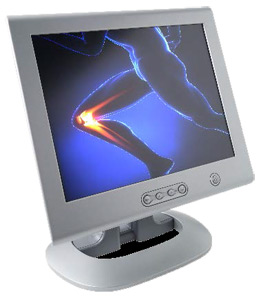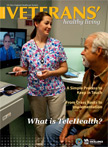Veterans' Healthy Living, Summer 2013
Caregiver Support
The Home Telehealth Dementia Support Program at the White River Junction Vermont VA facility is fairly new with only a handful of participants, but it has already helped immensely. The program is helping relieve the daily stresses of dementia patient caregivers with an interactive dialogue via the Home Telehealth machine.
Cheryl Yelle, RN, Home Telehealth, said, “Sometimes when we ask spouses or caregivers at an appointment how things are going, they put on a happy face because they are in the presence of a loved one. They may say things are going fine when they are not.”With the Home Telehealth support program, a caregiver is able to voice an opinion without worry or concern of adding stress to the patient.
The system includes a 28-day dialog that changes daily and asks questions such as “Do you feel like you don’t have enough time to yourself?” The machine provides feedback, tips, and educational information about dementia in response to the caregiver’s answers. Yelle also provides reinforcement for the caregivers with regular phone calls or makes referrals that help overcome obstacles. One caregiver, commented that the program was helpful and praised Yelle for providing outstanding assistance.

In 2012, 15.4 million family and friends provided 17.5 billion hours of unpaid care to those with Alzheimer’s and other dementias...eighty percent of care provided in the community is provided by unpaid caregivers.
http://www.alz.org/alzheimers_disease_facts_and_figures.asp#quickFacts
Making Life Easier
A mere year and a half ago, the TeleRehabilitation Program began as a pilot program and has since grown by leaps and bounds. In that short amount of time, it has progressed so that patients can now use their own home computers for a video interaction with specialists for physical rehabilitation.
 Initially, therapy for patients focused on total hip or knee replacements. "Often patients would start therapy when in the hospital after surgery, and then they would go home and require home care services to come by for follow up care. Some home care services were contracted outside the VA and made coordinating care difficult," said Jason Zullo, Service Line Manager for Sensory and Physical Rehabilitation. Because it is frequently a major endeavor for post-surgical patients to leave their homes during the early weeks after surgery, Mr. Zullo, along with many others, felt that follow-up care would be far more convenient for everyone if patients could receive their therapy at home. The results—the TeleRehabilitation Program—decreases drive time for everyone and increases the number of patients the VA can serve.
Initially, therapy for patients focused on total hip or knee replacements. "Often patients would start therapy when in the hospital after surgery, and then they would go home and require home care services to come by for follow up care. Some home care services were contracted outside the VA and made coordinating care difficult," said Jason Zullo, Service Line Manager for Sensory and Physical Rehabilitation. Because it is frequently a major endeavor for post-surgical patients to leave their homes during the early weeks after surgery, Mr. Zullo, along with many others, felt that follow-up care would be far more convenient for everyone if patients could receive their therapy at home. The results—the TeleRehabilitation Program—decreases drive time for everyone and increases the number of patients the VA can serve.
Mr. Zullo said that when compared to other VA facilities in the country, the White River Junction Vermont facility is small, but the TeleRehabilitation Programtreats the second largest volume of PT patients utilizing virtual care in the nation and the fourth highest for Telehealth Occupational Therapy. The TeleRehabilitation Program at White River Junction has seen over 400 patients and achieved well over 700 virtual visits in this fiscal year.
What is Telehealth | IP Video into the Home | Caregiver Support and TeleRehab
TeleMOVE! and TeleMental Health | TeleDermatology and TeleRetinal

















